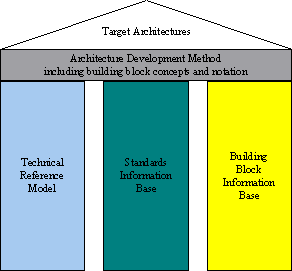
An architectural framework is a tool that can be used to describe a family of related architectures, allowing an individual architecture to be created by selection from and modification of the framework components. It describes an information system in terms of a model, made up from a set of conceptual building blocks, and shows how the building blocks fit together.
TOGAF consists of two main parts:
The Architecture Development Method and Technical Reference Model are universally applicable, and therefore can be used to build any system architecture.
The list of standards and specifications in the Standards Information Base is designed to facilitate choice by concentrating on open standards so that architectures derived from the framework will have good characteristics of interoperability and software portability, but the method specifically includes extending the list of specifications to allow for coexistence with or migration from other architectures.
In particular, the method shows how an iterative process can be used to combine sets of components into building blocks and to refine the definition and selection of building blocks to achieve the maximum benefit.
Future developments of the architectural framework will extend the range of information recorded and introduce interactive tools to facilitate the use of that information in selecting building blocks. The intention is to extend TOGAF with a Building Blocks Information Base (BBIB), containing information about architectural and solution building blocks for use in architecture design. The BBIB will be developed either as an extension to the existing SIB or as a separate but related information base.

Figure 1: Overview of TOGAF in the Future
Copyright © The Open Group, 1998, 1999, 2000